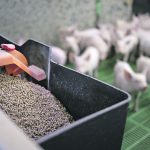Researchers determine that a storage period of 30 days at 24 C reduces risk of viral contamination in plant-based feed
Multiple disease-causing viruses have been proven to survive for extended periods in imported plant-based animal feed, but what temperature can kill them? Researchers released data on the issue earlier this year. They want to develop science-based procedures to safely import essential ingredients from countries afflicted with animal viruses. “We wanted to determine at 30 days […] Read moreTag Archives disease research

Sheep researchers ask for deer poop
Dr. Susan Kutz/Collin Letain
Do deer defecate in the woods? Yes, and they also do it on other parts of the landscape. When they do, researchers want some of the material. A study underway at the University of Calgary’s faculty of veterinary medicine is aimed at learning about gastro-intestinal parasite diversity in Alberta’s deer. Researchers intend to compare parasite […] Read more
Study looks at good bacteria to reduce antibiotic use
Nearly everyone has seen the TV ads for probiotic yogurt, where a middle-aged woman eats a scoop of yogurt and it instantly cures her digestive ills. Scientists question the health benefits of such yogurts and the accuracy of such commercials, but there’s little doubt that the billions of bacteria in the gut are critical for […] Read more

Getting to the guts of the problem
What is the most complex organ in the human body? Most people would likely say the brain. But a team of researchers at the Agriculture Canada Lethbridge Research Centre says it is the intestines, and that’s true of livestock as well as humans. That’s why they are studying various aspects of bacteria interactions in the […] Read more

Tackling the scourge of wild boars
COLUMBUS, Ohio — Wild boars are wreaking havoc across the United States and parts of Canada. One agency within the U.S. Department of Agriculture has been given the task of trying to eliminate them because they are destructive and can carry foot-and-mouth disease, African swine fever, pseudorabies and parasites such as trichinellosis and screw worm. […] Read more

Cause of bean spot baffles experts
It’s nice to find a simple cause and a simple solution to a crop disease, but with cranberry bean marsh spot that’s probably not going to happen. Instead, researchers are reaching toward an understanding and building a complex response. “There’s a big environmental component to this disease,” said Bob Conner, an Agriculture Canada researcher at […] Read more

Prion proteins continue to baffle researchers
EDMONTON — Scientists are continuing to unravel the mystery of fatal prion diseases. “Prions induce fear, and a lot of the reaction comes from a fear-based response because we know in the case of mad cow disease, that has been transmissible to humans,” said Valerie Sim, a neurologist at the University of Alberta’s centre for […] Read more
Experts study how viruses evolve
EDMONTON — The average person is host to billions of diverse bacteria and viruses that live in a community called a microbiome. A 200 pound adult probably carries two to six lb. of bacteria, some of which may cause disease while others are necessary for life, said virologist Frank van der Meer of the University […] Read more

Experts eye retina for BSE link
U.S. researchers found infected animals respond more slowly to light and the retina begins to thin
A cow’s eyes are a window to the animal’s brain, say American researchers studying BSE. In a recently published paper, scientists with Iowa State University and the U.S. Department of Agriculture document how they used retina tests to detect animals infected with the disease months before they showed traditional signs of illness. Today, their tests […] Read more



